Plant Poisoning
Plant poisoning is usually difficult to diagnose. Different plants act in different ways and therefore produce different symptoms. Diagnosis often has to rest on the history as frequently symptoms and lesions are rarely characteristic. The fact that animals had access to a particular plant or been seen to be eating it, the presence of identifiable fragments in the stomach and the fact that the animals were strangers to the district should be taken into consideration when attempting to reach a diagnosis.
It should be noted that most plants with yellow flowering heads are toxic to stock but, unless the grazing is very sparse, they will avoid eating them.
Some plants are poisonous at certain stage of growth and not at others. For example potatoes are particularly poisonous after they have turned green on exposure to light. Certain parts of a plant may be safe to eat while other parts may not be safe.
Numerous plants have been incriminated as the cause of poisoning in livestock and a few of these are detailed below.
General Diagnosis of Plant Poisoning
This is not easy and may require the assistance of a skilled veterinarian to differentiate the symptoms observed from those of infectious diseases. Plant poisoning is not common but when it does occur it may have devastating effects so rapid diagnosis is vital.
If plant poisoning is suspected often there are signs of gastrointestinal involvement. The gut should be inspected to see if any pieces of plant can be identified.
The sudden death of newly introduced animals may arouse suspicion of plant poisoning. Certain plant poisonings may be more common during times of drought when animals may be forced to eat plants they might otherwise avoid.
Inspection of grazing areas may reveal known toxic plants. When several animals are taken ill at the same time plant poisoning may be suspected.
Prevention, Control and Treatment
The most important plank in prevention is by not allowing animals access to plants which may cause poisoning. This may be difficult when the responsible plants are those which may be normally safe to eat at certain stages of growth and not at others. But if there are known poisonous plants in an area these should either be physically removed or animals should not be allowed to graze there. Well fed animals are less likely to sample poisonous plants than animals which are hungry. In times of drought try to supply supplementary feed.
Treatment
in many cases, in the absence of a specific diagnosis, treatment has to be symptomatic, but if poisoning is suspected any of the following can be tried (adapted from Forse 1999).
- Giving a purgative, such as Epsom's salts, may help to remove the toxin from the gut. Give 100g Epsom salt in half litre of water to small animals and up to 500 g Epsom salt in 1 litre of water for large animals given by mouth. Only use about 50 g Epsom salt for horses. Epsom salt (magnesium sulphate) is useful for treating poisoning. It makes more water go into the intestines from the body and gives the animal diarrhea so most of the poison in the intestines mixes with water and comes out as diarrhea.
- Mix kaolin (fine white clay powder) in water until it is a milky liquid. Give by mouth. For a large animal use about 200g Kaolin for a small animal about 10 g. Give every day for a few days if needed.
- Mixing a handful of charcoal powder in a bottle of clean water and give the solution by mouth may help in some cases. Charcoal can inactivate poisons in the stomach.
- Give milk or coconut milk by mouth
- Mix ground cereals or rice with water and give by mouth
- Mix 6 eggs and half kilo of sugar with about 1 litre of water and give by mouth.
- Animals which are depressed may benefit from the administration of stimulants.
- Animals which are excited may benefit from sedatives.
- In some cases, eg Prussic Acid Poisoning, or Nitrate/Nitrite Poisoning, there is a specific antidote, but in the majority of plant poisoning there is not and so one has to treat the symptoms as they appear.
Poisonous plants
Numerous plants have been incriminated as the cause of poisoning in livestock and a few of these are detailed below.
Acokanthera
These small spreading trees have received much notoriety as being the main provider of many arrow poisons. The leaves are glossy and pointed. Being ever green the tree is attractive to stock when conditions are dry. Although the ripe fruits are edible it may be presumed that all other parts of the tree are poisonous.
Symptoms:
In cattle death occurs suddenly, but rapid shallow breathing may be seen together with diarrhoea. Other symptoms include muscular spasms, teeth grinding, grunting respirations, and a profuse, clear, slimy nasal discharge. Post mortem reveals gastroenteritis, pale pink lungs distended with air and haemorrhages within the heart.
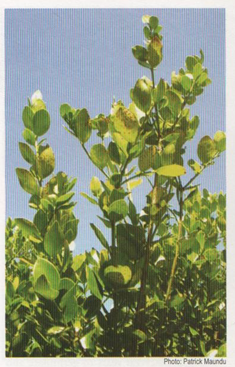
|
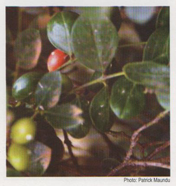 |
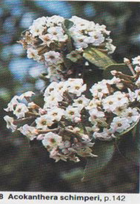 |
Bracken (Pteridium aquilinum)
In marginal, highland areas of Kenya bracken fern is to be found and is responsible for isolated cases of stock poisoning, mainly in cattle.
Symptoms:
- In single-stomached animals such as horses and pigs, poisoning is related to a deficiency of thiamine (vitamin B1) resulting in loss of appetite, weight loss, incoordination, trembling, rapid heart beat and death.
- In cattle bracken poisoning results in bone marrow depletion and anaemia. There is no deficiency of vitamin B1 in cattle as they are able to manufacture this vitamin in the rumen.
- Bracken poisoning is usually cumulative and may require up to three months to develop and sometimes animals have already been moved to a different pasture when symptoms develop. Both the leaves and the roots of the bracken fern are toxic.
- Symptoms are those of an acutehaemorrhagic syndrome, with clots of blood in the faeces, bleeding from body orifices, failure of blood to clot, a high temperature, loss of weight, and death with multiple haemorrhages throughout the carcase.
- Swelling of the larynx and difficulty in breathing has been reported in young cattle. One characteristic clinical picture in bracken poisoning in cattle is Chronic Enzootic Haematuria with tumours and haemorrhages in the urinary bladder which ultimately causes death from anaemia.
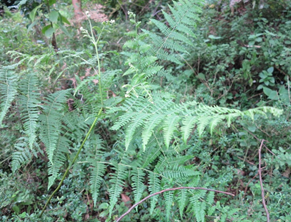
|
Prevention: The most important thing to do is to remove all animals from areas where bracken in growing or uproot all bracken ferns from the pastures continuously as they germinate.
Treatment: to treat horses poisoned by bracken is very effective if started early. Thiamine is given intravenously at the rate of 5mg/kg every 3 hours and then intramuscularly for several days. Treatment of affected cattle is generally much less successful and the recommended treatment with the hard- to- obtain batyl alcohol of doubtful value.
Castor Oil Plant (Ricinus communis)
This is a widespread soft woody shrub or small tree up to 20 feet tall, with large leaves- up to 2 feet long and wide- divided into 5 -11 lobes shaped like the fingers of a hand, with small yellowish flowers and seeds shaped like beans of various colours - red, brown, cream and black. Oil from the seed is used in medicine and industry and the oil is not poisonous, but all other parts of the plant are poisonous. The residue of the seed after extraction of the oil contains ricin.
The main danger to stock is when maize and other crops become contaminated with castor oil seeds due to careless farming or storage.
Symptoms in cattle include bloody diarrhoea. In horses inco-ordination, muscular spasms, and profuse watery diarrhoea have been seen, followed by collapse.
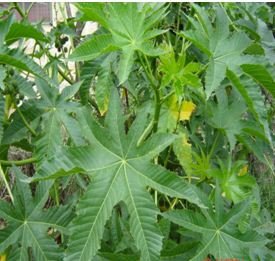
|
Cestrum auranticum
This is an introduced flowering shrub/tree with golden yellow pendant blooms and white berries. Its importance lies in the fact that poisoning produces symptoms similar to those of Rabies.
In the Limuru highland areas very many cases of poisoning have happened due to cows eating wildings of this plant which stay green during the dry season. A few leaves only will kill a grown cow. Affected cows are irritable and hypersensitive to any external stimuli. Sudden sounds or poking with a stick causes affected animals to jump as though they had received an electric shock. On some occasions animals charge with wide open eyes any moving object. Prior to death there may be frequent bellowing followed by paralysis starting at the hindquarters. When opening such a case of poisoning it can be seen that the stomach lining has completely detached from the stomach walls, and it is evident that the death has been very painful.
If this tree is common in the neighborhood it is very important to recognize the leaves and uproot any little seedling in the pasture and removing it from the area. Whereas cattle may stay away from a green plant as it is very bitter, the smell of a cut dry plant left in the boma will not give the same warning but the dry plant is equally poisonous.
Cotton Seed
Cotton seed contains a toxic substance called Gossypol, which can be poisonous to young ruminants and pigs. This toxin rarely affects adult cattle. It is destroyed by heat. Cotton seed cake which has been produced by heat treatment is therefore safe. But cotton seed is not safe to be given to young ruminants or to pigs. Clinical signs do not appear until after animals have been fed rations containing cotton seed for 1-3 months. These include loss of appetite, weight loss, weakness, rapid breathing and increased susceptibility to stress. Death may occur. There is no effective treatment and in cases of suspected poisoning all cotton seed products should be removed from the diet.
Crotalaria

|
These plants are responsible for causing chronic liver damage and laminitis of the hooves. In the former, especially in horses, symptoms include lack of appetite, dullness, wasting, irritability, yawning and aimless walking and a slow staggering gait. In the latter, severe hoof damage results in the affected animal walking on its heels. In some cases the hoof may become deformed and warty.
Datura stramonium
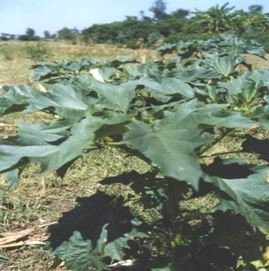
|
This is a shrubby herb, 6 inches to 6 feet tall, with almost hairless stems. It has white trumpet like flowers and black, kidney-shaped seeds. It is found between 3000 and 7000 feet. Many cases of poisoning have occurred, mostly human, when seedlings have been mistaken for, or mixed with spinach-like vegetables, or in animals, when the dried plant has become mixed with hay and other foods.
The fresh plant is unpleasantly scented, particularly when bruised, and is therefore avoided by stock.
Signs of poisoning: In cattle paralysis, rapid heart action and death by asphyxia occur.
Datura candida and Datura aborea are the well-known "moon flowers", shrubs with long, white, trumpet-shaped flowers which are fragrant at night. The toxic element in Datura species is an alkaloid.
Hydrocyanic Acid or Prussic Acid Poisoning.
Found in such plants as clover, red oat grass, star grass, and sorghum
Hydrocyanic or prussic acid is a protoplasmic poison which inhibits the oxidative enzyme systems of cellular respiration necessary for the transport of oxygen from the blood to the tissues and causes death by depriving the cells of the body and those of the respiratory centre of oxygen. Oxygen exchange is suspended and oxygen is retained in the blood, giving it a characteristic bright red colour.
A variety of plants under certain conditions contain cyanogenic glycosides which when hydrolysed during digestion yield hydrocyanic acid. Such plants include clover, red oat grass, star grass, and sorghum.
At the early stage of rapid growth such plants contain greater quantities of glycoside than the mature plant and wilted plants are more dangerous than fresh plants because of their high content of preformed hydrocyanic acid. If the normal growth of such plants is checked, for example by drought, trampling or frost, there is a tendency for the amount of free acid in the plant to increase.
Poisoning is always acute, occurring within half an hour to a few hours after ingestion of the responsible plants. There is difficulty in breathing, staggering, tail-twitching, rapid respirations, salivation, muscle twitching, rapid heart rate, collapse and death often within less than half an hour of the onset of symptoms. Death is accompanied by severe asphyxial convulsions. The blood of affected animals is often a bright cherry red as may be the mucous membranes. When the rumen is opened there is often the characteristic smell of "bitter almonds". This is a very dramatic poisoning, caused not by a particular plant which is inherently poisonous, but by certain pasture plants which under most conditions are not poisonous. Treatment must be immediate and involves the antidotes Sodium Nitrite and Sodium Thiosulphate. The former is given as 10ml of a 20% solution i/v followed by 30mls of a 20% solution of sodium thiosulphate also i/v. Alternatively sodium thiosulphate may be given alone at 500mg/kg i/v plus 30g per cow by mouth to detoxify any remaining hydrocyanic acid in the rumen. If large numbers of animals are affected then speed of treatment may preclude i/v treatment and the following has been found to be effective - mix 3g sodium nitrite and 15g sodium thiosulphate together in 30ml sterile water and give by s/c injection.
Prevention involves preventing cattle from grazing potentially dangerous plants such as sorghum when they are immature, frosted, wilted or trampled. Sorghum in particular should be in flower before they are grazed or chopped to be fed green.
Lantana species
There are various species of this shrub, including the introduced Lantana camara. This has coarse, branched stems with small curved prickles and flower heads of various colours, including red, yellow and white. Being unpalatable to stock it is normally avoided, but when occasionally ingested, causes photosensitization and gastro-intestinal disturbances.

|
Leucaena leucocephalia
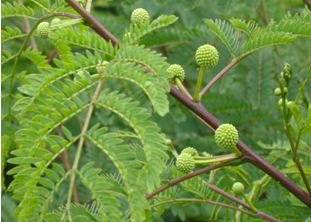
|
This tree is often used as forage for animals, but they get poisoned if they eat too much of it. The tree has a poison called mimosin in it. Horses are poisoned most often but also cattle, goats, sheep and pigs can be poisoned. Some animals are more sensitive to poison than others.
Prevention: Avoid giving animals more than half their food as leucaena. It is best to give only abouth a tenth of the feed as Leucaena.
Treatment: Stop feeding Leucaena immediately. When starting again after some time, feed only small amounts
Oenanthe palustris
This plant is also called water parsnip or water celery and is found in swampy places by rivers and streams in highland areas and remains green throughout the year. Thus it is often eaten by stock at watering places during the dry season. When plant poisoning is suspected on a farm immediate examination should be made of all watering points which are accessible to stock. The initial green shoots of the plant, which often come up in ditches before grass appears, are particularly poisonous, as are also the roots.
Symptoms include violent trembling, noisy rapid breathing, profuse diarrhoea, staggering, rotation of the head and neck, dullness, drowsiness, coma and death.
Prevention: This plant should always be eradicated when found.
Oleander
This ornamental shrub, which grows throughout East Africa from sea level up to and over 6000 feet, is up to 15 feet tall. The flowers are pink or white and the leaves dark green. All parts of the plant are poisonous and horses and cattle have died after eating a single growing branchlet. In cattle lethargy, lack of appetite, cessation of rumination, bloat and foetid diarrhoea have been some of the symptoms seen after eating oleander. Later on colic, dilation of the pupils, rapid breathing, teeth grinding, continuous urination and bloody foetid diarrhoea set in. Finally convulsions and paralysis preceded death.
Phytolacca dodecandra
It has been reported that this straggling bushy plant about 3 - 12 feet tall that can also become a climber is responsible for more plant poisonings in East Africa than any other. The bark and roots are very poisonous, the leaves and green fruits less so, while the ripe fruits appear to be harmless in small quantities. Cattle and sheep eat the soft juicy leaves when grass is scarce in times of drought. The seeds contain saponin and can be used as soap and to control of water snails to reduce billharzia
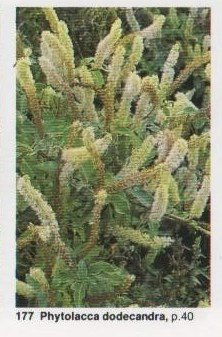
|
Symptoms: Depression, quivering of the muscles, increased urination and foetid diarrhoea and frothing at the mouth have been reported. On post mortem intense congestion of the stomach and intestines is found together with haemorrhages within the left ventricle of the heart. Eradication of this plant is the only practical method of control
Senecio
All species of Senecio should be regarded with suspicion. Fifty species have been recorded from East Africa . In Europe ragwort poisoning is well recognized. Poisoning is usually chronic with death usually occurring two to several months after commencement of feeding on the plant. Cirrhosis of the liver leads to loss of condition, lack of appetite, jaundice, and later to various nervous symptoms, including yawning, drowsiness, and a staggering gait. In cattle nervous derangement usually takes the form of mania. Acute poisoning is uncommon.
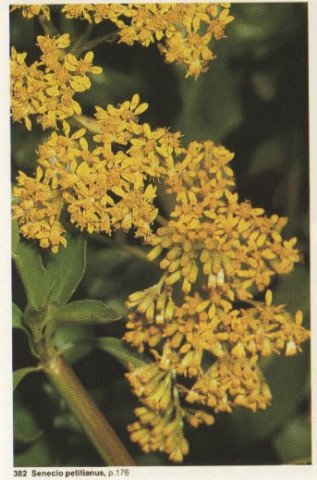
|
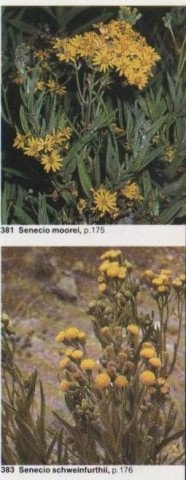 |
Tribulus
Tribulus terrestris is a small plant, creeping flat on the ground, spreading for a few inches and has yellow flowers, small hairy leaflets and flattened fruit. It is widespread throughout the tropics up to 7000 feet, especially in open or sandy ground.
This plant contains a hepatotoxin, a poison which damages the liver. This causes photosensitization in affected animals, usually sheep. Sometimes there is swelling of the head, fever and jaundice, refusal to eat, and discharge from the eyes and nose. Wilting of the plant appears to increase its toxicity. Goats seem to be unaffected and in cattle the young plant is liable to cause non-fatal bloat.
 |
